Lamiales
plant order
Introduction
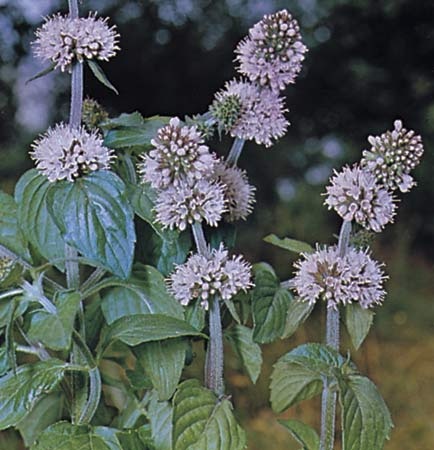 mint order of flowering plants, including 23 families and more than 23,000 species. The main families in the order are Lamiaceae, Verbenaceae, Plantaginaceae, Scrophulariaceae, Orobanachaceae, Acanthaceae, Gesneriaceae, Bignoniaceae, Oleaceae, Pedaliaceae, and the small carnivorous families Byblidaceae and Lentibulariaceae.
mint order of flowering plants, including 23 families and more than 23,000 species. The main families in the order are Lamiaceae, Verbenaceae, Plantaginaceae, Scrophulariaceae, Orobanachaceae, Acanthaceae, Gesneriaceae, Bignoniaceae, Oleaceae, Pedaliaceae, and the small carnivorous families Byblidaceae and Lentibulariaceae.Lamiales belongs to the core asterid, or sympetalous lineage of flowering plants, in the Asterid I group of the Angiosperm Phylogeny Group II (APG II) botanical classification system (see angiosperm). In its current concept it is much broader than in the previous concept, under the Cronquist classification system, as Lamiales now includes families that Cronquist treated in the orders Bignoniales and Scrophulariales.
Order characteristics
 The expanded order is more heterogeneous than before, though this expansion is supported by a substantial number of technical and molecular characters. For instance, carbohydrates are stored as oligosaccharides and not as starch; leaves have specialized stomata; and plants often produce oxygenated flavones and other unique chemical compounds. More easily recognizable characters include usually opposite leaves, frequent presence of glandular hairs, and mostly capsular fruits.
The expanded order is more heterogeneous than before, though this expansion is supported by a substantial number of technical and molecular characters. For instance, carbohydrates are stored as oligosaccharides and not as starch; leaves have specialized stomata; and plants often produce oxygenated flavones and other unique chemical compounds. More easily recognizable characters include usually opposite leaves, frequent presence of glandular hairs, and mostly capsular fruits. Many members of the order have bilaterally symmetric flowers (irregularly shaped corollas, with only one plane of symmetry down the middle), with fewer stamens than petals. In many species the corolla has two lips, the upper lip being composed of two petals and the lower of three. The number of petals in each lip is sometimes not obvious; lips may be the same size, or one may be markedly larger. An upward bulge, the palate, in the central portion of the lower lip is pronounced in some species, such as Antirrhinum majus (the common snapdragon), in which it closes the corolla throat. The base of the corolla may bear a backwardly projecting spur, as in Cymbalaria muralis (Oxford-ivy), Linaria (linarias), Lentibularia (bladderworts (bladderwort)), and Pinguicula (butterworts); this spur is the site of nectar production.
Many members of the order have bilaterally symmetric flowers (irregularly shaped corollas, with only one plane of symmetry down the middle), with fewer stamens than petals. In many species the corolla has two lips, the upper lip being composed of two petals and the lower of three. The number of petals in each lip is sometimes not obvious; lips may be the same size, or one may be markedly larger. An upward bulge, the palate, in the central portion of the lower lip is pronounced in some species, such as Antirrhinum majus (the common snapdragon), in which it closes the corolla throat. The base of the corolla may bear a backwardly projecting spur, as in Cymbalaria muralis (Oxford-ivy), Linaria (linarias), Lentibularia (bladderworts (bladderwort)), and Pinguicula (butterworts); this spur is the site of nectar production.
 In some families of the order, the androecium (stamens) is constructed on a two-part (dimerous) or a four-part (tetramerous) plan, both associated with corollas that are regular or essentially so. For example, species of Oleaceae (e.g., Ashes, forsythias (forsythia), jasmine, and lilacs (lilac)) typically have two stamens, and species of Buddleja ( butterfly bush; a member of Scrophulariaceae) typically have four. In other families of the order, the androecium is constructed on a five-part (pentamerous) plan, associated mostly with corollas that are irregular. In these species departures from a full set of five stamens derive clearly from the suppression of one or more of the five. Thus, a few members of the order have five stamens (as in the mulleins (mullein); members of Scrophulariaceae), but most have only two or four. Species with four stamens (an upper pair and a lower pair) lack only the uppermost stamen. Other species lack the uppermost stamen and either the upper or the lower pair, leaving only two stamens. Any of the lost stamens may be represented by a staminode, or sterile stamen, borne in place of a normal stamen but not producing pollen. Depending on the species, a staminode may range from a minute projection on the inner surface of the corolla to an elongated filament-like structure equal in size and conspicuousness to the normal stamens (e.g., penstemon). In most species of the order, the stamen filaments are united with the petals (epipetaly), the degree of union ranging from slight to considerably more than half the length of the stamen. The stamens are alternate with the lobes of the corolla; that is, they are attached between the petals. In some highly irregular flowers, the alternate arrangement is difficult to see. The anthers of all members of the order have four pollen sacs. Pollen form and structure are exceedingly diverse. One family of the order, Acanthaceae, shows a wider range of pollen morphological features than almost any other family of flowering plants.
In some families of the order, the androecium (stamens) is constructed on a two-part (dimerous) or a four-part (tetramerous) plan, both associated with corollas that are regular or essentially so. For example, species of Oleaceae (e.g., Ashes, forsythias (forsythia), jasmine, and lilacs (lilac)) typically have two stamens, and species of Buddleja ( butterfly bush; a member of Scrophulariaceae) typically have four. In other families of the order, the androecium is constructed on a five-part (pentamerous) plan, associated mostly with corollas that are irregular. In these species departures from a full set of five stamens derive clearly from the suppression of one or more of the five. Thus, a few members of the order have five stamens (as in the mulleins (mullein); members of Scrophulariaceae), but most have only two or four. Species with four stamens (an upper pair and a lower pair) lack only the uppermost stamen. Other species lack the uppermost stamen and either the upper or the lower pair, leaving only two stamens. Any of the lost stamens may be represented by a staminode, or sterile stamen, borne in place of a normal stamen but not producing pollen. Depending on the species, a staminode may range from a minute projection on the inner surface of the corolla to an elongated filament-like structure equal in size and conspicuousness to the normal stamens (e.g., penstemon). In most species of the order, the stamen filaments are united with the petals (epipetaly), the degree of union ranging from slight to considerably more than half the length of the stamen. The stamens are alternate with the lobes of the corolla; that is, they are attached between the petals. In some highly irregular flowers, the alternate arrangement is difficult to see. The anthers of all members of the order have four pollen sacs. Pollen form and structure are exceedingly diverse. One family of the order, Acanthaceae, shows a wider range of pollen morphological features than almost any other family of flowering plants.Most species in the order have an ovary with two locules, or chambers, each representing a single carpel. Most families in the order have axile placentation (the ovules, or placentae, develop on a central column in the ovary), although some, such as Orobanchaceae and Gesneriaceae, have parietal placentation (the ovules are positioned along the outer walls of the ovary or along partial partitions extending inward). Lentibulariaceae is characterized by free-central placentation, in which the ovules are borne on a central stalk that arises from the base of the single locule.
 Although most species of Lamiales produce several to many seeds per fruit, a few produce only one (ashes, some species of Globularia). Perhaps the record for seed production in the order goes to a member of Orobanchaceae, Boschniakia rossica, a small parasitic plant that produces more than a quarter of a million seeds. The size of seeds in the order ranges from that of some members of Bignoniaceae, which may be several centimetres long, though thin and light, to the dustlike seeds of broomrapes (Orobanchaceae), which may be less than 0.3 mm (0.01 inch) long.
Although most species of Lamiales produce several to many seeds per fruit, a few produce only one (ashes, some species of Globularia). Perhaps the record for seed production in the order goes to a member of Orobanchaceae, Boschniakia rossica, a small parasitic plant that produces more than a quarter of a million seeds. The size of seeds in the order ranges from that of some members of Bignoniaceae, which may be several centimetres long, though thin and light, to the dustlike seeds of broomrapes (Orobanchaceae), which may be less than 0.3 mm (0.01 inch) long.Main families
The two core families of Lamiales are Lamiaceae, or the mint family, and Verbenaceae, or the Verbena family. Together they account for about 270 genera and more than 8,300 species. Both families have opposite leaves, bilaterally symmetric flowers (with only one plane of symmetry down the axis of the irregularly shaped flowers), and two or four stamens. The ovary in these families is very characteristic: there are two carpels, each with two ovules, but each carpel is divided by a secondary partition to produce four chambers with one ovule or seed apiece. The style arises either deeply from within a central depression (Lamiaceae) or from the top of the ovary (Verbenaceae). Typically in the mints, the fruit separates into four nutlets when mature. Fruits in the verbena family may also split apart, but many are berries or drupes (drupe) (the outer layer fleshy, but the inner one stony).
Lamiaceae
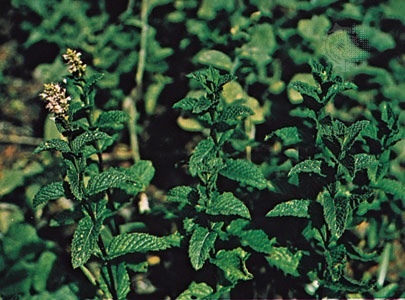 Most members of Lamiaceae are annual or perennial herbs, but molecular studies at the end of the 20th century indicated that some of the woody genera formerly placed in Verbenaceae should be placed in Lamiaceae for the two families to remain phylogenetically separate. Delimited this way, there are 236 genera and more than 7,000 species in Lamiaceae. The primary centre of distribution of the mint family is the Old World, from the Canary Islands to the Himalayas, with lesser centres in Ethiopia, Madagascar, southern areas of Africa and India, Sri Lanka, and oceanic regions eastward. Centres of distribution in the New World range from the mountains in central Mexico into Argentina and Chile, with secondary centres radiating northward and eastward.
Most members of Lamiaceae are annual or perennial herbs, but molecular studies at the end of the 20th century indicated that some of the woody genera formerly placed in Verbenaceae should be placed in Lamiaceae for the two families to remain phylogenetically separate. Delimited this way, there are 236 genera and more than 7,000 species in Lamiaceae. The primary centre of distribution of the mint family is the Old World, from the Canary Islands to the Himalayas, with lesser centres in Ethiopia, Madagascar, southern areas of Africa and India, Sri Lanka, and oceanic regions eastward. Centres of distribution in the New World range from the mountains in central Mexico into Argentina and Chile, with secondary centres radiating northward and eastward. Members of Lamiaceae are commonly recognized by their opposite, usually saw-toothed leaves, often regular or condensed clusters of flowers, and more or less square stems. Their flowers commonly have a style that originates between the deep lobes of the ovary (gynobasic style), uniting the four otherwise essentially distinct lobes of the ovary. Members of the mint family are characteristically aromatic, and many are cultivated for their ethereal or essential oils. Essential oils, which are used medicinally, for flavoring foods and beverages, and in perfumery, are derived from many genera in the family. The oils from Marrubium vulgare ( horehound) and Salvia sclarea (clary) have medicinal value. Mentha cultivars (horticultural varieties) grown commercially for their oils are M. arvensis for menthol; M. gentilis and M. spicata for spearmint; and M. piperita for peppermint. Culinary herbs include Origanum majorana ( marjoram), O. vulgare ( oregano), Ocimum basilicum (sweet basil), Salvia officinalis ( sage), Satureja hortensis ( savory), Melissa officinalis (lemon balm), Thymus vulgaris ( thyme), and Rosmarinus officinalis ( rosemary). Perfumes are derived from Lavandula angustifolia ( lavender).
Members of Lamiaceae are commonly recognized by their opposite, usually saw-toothed leaves, often regular or condensed clusters of flowers, and more or less square stems. Their flowers commonly have a style that originates between the deep lobes of the ovary (gynobasic style), uniting the four otherwise essentially distinct lobes of the ovary. Members of the mint family are characteristically aromatic, and many are cultivated for their ethereal or essential oils. Essential oils, which are used medicinally, for flavoring foods and beverages, and in perfumery, are derived from many genera in the family. The oils from Marrubium vulgare ( horehound) and Salvia sclarea (clary) have medicinal value. Mentha cultivars (horticultural varieties) grown commercially for their oils are M. arvensis for menthol; M. gentilis and M. spicata for spearmint; and M. piperita for peppermint. Culinary herbs include Origanum majorana ( marjoram), O. vulgare ( oregano), Ocimum basilicum (sweet basil), Salvia officinalis ( sage), Satureja hortensis ( savory), Melissa officinalis (lemon balm), Thymus vulgaris ( thyme), and Rosmarinus officinalis ( rosemary). Perfumes are derived from Lavandula angustifolia ( lavender).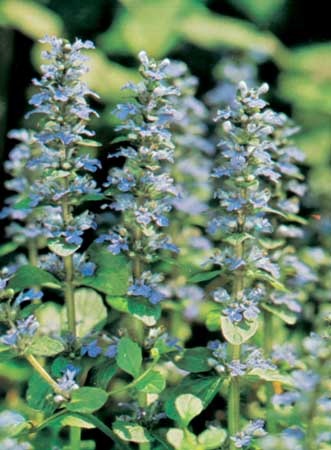 Border, bedding, and groundcover plants of the mint family include Lavandula, Mentha, and Lamium maculatum (the so-called dead-nettle, a semievergreen). Ajuga reptans (carpet bugleweed), native to Europe, spreads by stolons (above-ground runners), and A. pyramidalis produces rhizomes (rhizome) to form enlarged colonies vegetatively. Other ornamental mints include numerous species of Salvia, ranging in colour from blue to the orange-red S. splendens (Brazilian scarlet-sage). Molucella laevis (shell flower) (bells-of-Ireland) develop an unusual green open-faced calyx much used in floral arrangements. Hundreds of named cultivars of Plectranthus, notable for their colourful leaves, are prized as houseplants and for protected outdoor plantings. Wildflowers and cultivated varieties of Monarda (bergamots (bergamot)) are also appreciated for their colour in summer.
Border, bedding, and groundcover plants of the mint family include Lavandula, Mentha, and Lamium maculatum (the so-called dead-nettle, a semievergreen). Ajuga reptans (carpet bugleweed), native to Europe, spreads by stolons (above-ground runners), and A. pyramidalis produces rhizomes (rhizome) to form enlarged colonies vegetatively. Other ornamental mints include numerous species of Salvia, ranging in colour from blue to the orange-red S. splendens (Brazilian scarlet-sage). Molucella laevis (shell flower) (bells-of-Ireland) develop an unusual green open-faced calyx much used in floral arrangements. Hundreds of named cultivars of Plectranthus, notable for their colourful leaves, are prized as houseplants and for protected outdoor plantings. Wildflowers and cultivated varieties of Monarda (bergamots (bergamot)) are also appreciated for their colour in summer. Several important timber plants were formerly placed in Verbenaceae, but, on the basis of molecular and phylogenetic criteria, they were reassigned to Lamiaceae. These include Tectona grandis, the teak native to India, Myanmar, and Malaysia that is also grown in other warm areas for its valuable wood, and Gmelina arborea, an Old World species now widely cultivated for timber and firewood because of its rapid growth. Another cultivar that was reassigned is Vitex altissima (Asian tree), which produces commercial timber; wood of the related V. divaricata is used for shingles, and the bark is used for tanning. A related smaller tree, the aromatic V. agnus-castus (chaste tree), is a hardy ornamental in warm temperate regions. The evergreen Callicarpa americana (beautyberry) is another genus moved into Lamiaceae.
Several important timber plants were formerly placed in Verbenaceae, but, on the basis of molecular and phylogenetic criteria, they were reassigned to Lamiaceae. These include Tectona grandis, the teak native to India, Myanmar, and Malaysia that is also grown in other warm areas for its valuable wood, and Gmelina arborea, an Old World species now widely cultivated for timber and firewood because of its rapid growth. Another cultivar that was reassigned is Vitex altissima (Asian tree), which produces commercial timber; wood of the related V. divaricata is used for shingles, and the bark is used for tanning. A related smaller tree, the aromatic V. agnus-castus (chaste tree), is a hardy ornamental in warm temperate regions. The evergreen Callicarpa americana (beautyberry) is another genus moved into Lamiaceae. Verbenaceae
 Verbenaceae, or the verbena (also known as vervain) family, contains 34 genera and nearly 1,200 species, which are distributed mostly in tropical and subtropical South America and Africa. Other places of origin include central Asia, Japan, and islands near India; a few members are native to Europe, Asia Minor, and North America. In Verbenaceae the style is terminal on the ovary, or nearly so, and the ovary is unlobed or only shallowly lobed at the top. The plants are sometimes aromatic, and the fruit is not as consistently specialized as that found in Lamiaceae. The flowers tend to be more loosely aggregated than in the mints.
Verbenaceae, or the verbena (also known as vervain) family, contains 34 genera and nearly 1,200 species, which are distributed mostly in tropical and subtropical South America and Africa. Other places of origin include central Asia, Japan, and islands near India; a few members are native to Europe, Asia Minor, and North America. In Verbenaceae the style is terminal on the ovary, or nearly so, and the ovary is unlobed or only shallowly lobed at the top. The plants are sometimes aromatic, and the fruit is not as consistently specialized as that found in Lamiaceae. The flowers tend to be more loosely aggregated than in the mints. Important core Verbenaceae include plants such as Lippia (lemon verbena), Lantana camara (common Lantana), Petraea (queen's wreath), and Verbena hybrida, an attractive ground cover.
Important core Verbenaceae include plants such as Lippia (lemon verbena), Lantana camara (common Lantana), Petraea (queen's wreath), and Verbena hybrida, an attractive ground cover.Restructuring of Scrophulariales
Plantaginaceae
 One of the biggest upheavals (and uncertainties) in family circumscriptions resulting from the adoption of the APG II classification lies within the part of Lamiales that used to be called Scrophulariales. Molecular studies showed that earlier morphologically based delimitations of families, such as Scrophulariaceae, do not hold up well in a system based on common ancestry. Consequently, many familiar genera long treated as “scrophs” have been placed in families as surprising as Plantaginaceae, or the ribwort family. In fact, a current concept of Plantaginaceae includes Antirrhinum (common snapdragon), Veronica ( speedwell), Penstemon (beardtongue), Linaria (butter-and-eggs), and Digitalis ( foxglove), as well as Plantago (ribwort, known as plantain in the United States) and the aquatic genera Hippuris and Callitriche. The family, so defined, is entirely herbaceous and quite diverse in floral form and in the reduction of floral parts, with about 90 genera and 1,700 species. Plantago, for instance, has a single basal ovule, whereas many of the traditional “scroph” genera have numerous seeds on an axial placentation. The large slipper flower genus Calceolaria, with some 260 species, is placed in its own family, Calceolariaceae. The foxgloves (foxglove) Digitalis lanata and D. purpurea are the sources of digoxin and digitoxin, respectively; these drugs are important in the treatment of irregular heart rhythms.
One of the biggest upheavals (and uncertainties) in family circumscriptions resulting from the adoption of the APG II classification lies within the part of Lamiales that used to be called Scrophulariales. Molecular studies showed that earlier morphologically based delimitations of families, such as Scrophulariaceae, do not hold up well in a system based on common ancestry. Consequently, many familiar genera long treated as “scrophs” have been placed in families as surprising as Plantaginaceae, or the ribwort family. In fact, a current concept of Plantaginaceae includes Antirrhinum (common snapdragon), Veronica ( speedwell), Penstemon (beardtongue), Linaria (butter-and-eggs), and Digitalis ( foxglove), as well as Plantago (ribwort, known as plantain in the United States) and the aquatic genera Hippuris and Callitriche. The family, so defined, is entirely herbaceous and quite diverse in floral form and in the reduction of floral parts, with about 90 genera and 1,700 species. Plantago, for instance, has a single basal ovule, whereas many of the traditional “scroph” genera have numerous seeds on an axial placentation. The large slipper flower genus Calceolaria, with some 260 species, is placed in its own family, Calceolariaceae. The foxgloves (foxglove) Digitalis lanata and D. purpurea are the sources of digoxin and digitoxin, respectively; these drugs are important in the treatment of irregular heart rhythms. Scrophulariaceae
 A somewhat diminished Scrophulariaceae, or the figwort family, still includes some 65 genera and 1,700 species. These herbs or shrubs include genera such as Verbascum ( mullein, with about 360 species), Scrophularia (200 species), and Buddleja (butterfly bush, with 125 species, although this genus is sometimes separated into its own family, Buddlejaceae). Some of these genera, such as the mulleins, have the same number of stamens as petals. Where the genus Mimulus (monkey flower, 150 to 170 species) belongs is still not well settled. The APG II system indicates that it may belong together with Phryma in Phrymaceae, another member of the mint order, or else it is placed in Plantaginaceae.
A somewhat diminished Scrophulariaceae, or the figwort family, still includes some 65 genera and 1,700 species. These herbs or shrubs include genera such as Verbascum ( mullein, with about 360 species), Scrophularia (200 species), and Buddleja (butterfly bush, with 125 species, although this genus is sometimes separated into its own family, Buddlejaceae). Some of these genera, such as the mulleins, have the same number of stamens as petals. Where the genus Mimulus (monkey flower, 150 to 170 species) belongs is still not well settled. The APG II system indicates that it may belong together with Phryma in Phrymaceae, another member of the mint order, or else it is placed in Plantaginaceae.Myoporaceae is a former family of woody plants that is now included in Scrophulariaceae. The core genera include Eremophila (more than 200 species) and Myoporum (about 30 species), both consisting of trees native to Australia and the Pacific. It also includes Bontia daphnoides, an ornamental species from the Caribbean region. Members of the family have strongly bilaterally symmetric flowers, and most have leaves with pellucid dots.
Orobanchaceae
 Orobanchaceae, or the broomrape family, was also considerably expanded under APG II from its former delimitation. Instead of about 15 genera and 210 species of entirely parasitic plants (holoparasites, with no chlorophyll), the family now includes 99 genera and some 2,000 species. These additional groups are all hemiparastic plants; that is, they have green foliage and are photosynthetic (photosynthesis), but they also have specialized root connections (haustoria) that parasitize other green plants. Many of these were formerly placed in Scrophulariaceae, but molecular data and their partly parasitic habit place them squarely within Orobanchaceae. These include genera such as Castilleja (Indian paintbrush), with 200 species, Pedicularis ( lousewort), with as many as some 800 species, Agalinis, Buchnera, and Euphrasia. The completely parasitic members of Orobanchaceae include Orobanche (broomrape), with 150 species, and Epifagus (beechdrops), found only on roots of beech trees (Fagus grandifolia). Some of the genera are serious agricultural pests: Aeginetia and Christisonia attack sugarcane, while the witchweeds (witchweed) (Striga and Alectra) attack corn (maize), sugarcane, rice, sorghum, Peanuts (groundnuts), soybeans (soybean), and tobacco.
Orobanchaceae, or the broomrape family, was also considerably expanded under APG II from its former delimitation. Instead of about 15 genera and 210 species of entirely parasitic plants (holoparasites, with no chlorophyll), the family now includes 99 genera and some 2,000 species. These additional groups are all hemiparastic plants; that is, they have green foliage and are photosynthetic (photosynthesis), but they also have specialized root connections (haustoria) that parasitize other green plants. Many of these were formerly placed in Scrophulariaceae, but molecular data and their partly parasitic habit place them squarely within Orobanchaceae. These include genera such as Castilleja (Indian paintbrush), with 200 species, Pedicularis ( lousewort), with as many as some 800 species, Agalinis, Buchnera, and Euphrasia. The completely parasitic members of Orobanchaceae include Orobanche (broomrape), with 150 species, and Epifagus (beechdrops), found only on roots of beech trees (Fagus grandifolia). Some of the genera are serious agricultural pests: Aeginetia and Christisonia attack sugarcane, while the witchweeds (witchweed) (Striga and Alectra) attack corn (maize), sugarcane, rice, sorghum, Peanuts (groundnuts), soybeans (soybean), and tobacco. Acanthaceae
 Acanthaceae, or the acanthus family, is a large mostly tropical family with 229 genera and some 3,500 species. Most species have showy bilaterally symmetric flowers, and the family includes herbs, vines, shrubs, and even trees. There are often colourful bracts associated with the flowers, and in most members there is a specialized fruit-dispersal mechanism. The ovules are borne on a hook-shaped projection (called the retinaculum or jaculator) coming off the ovary placenta, and as the jaculator dries, it forcibly ejects the seeds away from the plant. Large genera in the family include Justicia (600 species), Barleria (300 species), and Ruellia (250 species). Important climbing genera are Thunbergia (black-eyed Susan, clock vine) and Mendoncia. The black mangrove genus Avicennia has sometimes been placed in its own family but is included in Acanthaceae under the APG II system. These plants inhabit the coastal mud flats of Florida and many tropical shorelines. Their leaves have salt glands on both sides, and the flowers are unusual for the order in having the same numbers of stamens as petals.
Acanthaceae, or the acanthus family, is a large mostly tropical family with 229 genera and some 3,500 species. Most species have showy bilaterally symmetric flowers, and the family includes herbs, vines, shrubs, and even trees. There are often colourful bracts associated with the flowers, and in most members there is a specialized fruit-dispersal mechanism. The ovules are borne on a hook-shaped projection (called the retinaculum or jaculator) coming off the ovary placenta, and as the jaculator dries, it forcibly ejects the seeds away from the plant. Large genera in the family include Justicia (600 species), Barleria (300 species), and Ruellia (250 species). Important climbing genera are Thunbergia (black-eyed Susan, clock vine) and Mendoncia. The black mangrove genus Avicennia has sometimes been placed in its own family but is included in Acanthaceae under the APG II system. These plants inhabit the coastal mud flats of Florida and many tropical shorelines. Their leaves have salt glands on both sides, and the flowers are unusual for the order in having the same numbers of stamens as petals. Gesneriaceae
Members of Gesneriaceae, or the African violet family, are usually herbs or vines and less often are shrubs or trees. The family is largely tropical and includes nearly 150 genera and 3,200 species. Many species have leaves that are opposite and softly hairy or somewhat fleshy; the calyx is often spurred, and the five joined petals form a two-lipped bilaterally symmetric tube with four or occasionally two anthers that are conspicuously joined in pairs by their pollen sacs. The fruits are berries or capsules with numerous seeds on a parietal placenta. The family is renowned for its ornamental genera, such as Streptocarpus (including Saintpaulia, the African violets), Sinningia ( gloxinia), Columnea, and Episcia. The variety and showiness of gesneriad flowers are related to a diversity of pollination systems, including bees, moths, butterflies, hummingbirds, flies, and bats.
Bignoniaceae
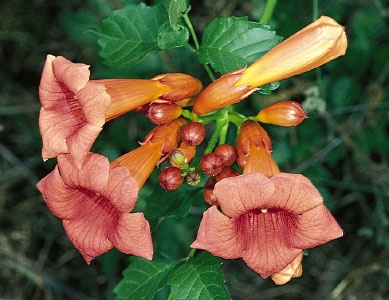 Bignoniaceae, or the trumpet creeper family, is a major tropical family with a few temperate region members, such as Campsis radicans (trumpet vine) and Catalpa. The family contains 110 genera and some 800 species. All members are woody, including trees, shrubs, and lianas. They can be recognized quite easily by their mostly opposite compound leaves, and the vines often have leaf tendrils. The flowers are generally large and bilaterally symmetric, and there are often nectaries on the leaf, stem nodes, calyx, or ovary surface. The calyx is often spathaceous; there are two series of ovules in each carpel; and the broad stigmatic lobes are often sensitive when touched. When the fruits are capsular, the seeds are usually flattened and winged. A few genera have large leathery berries that may once have been dispersed by large—now extinct—mammals, although elephants still act as dispersers for some African species. The genus Tabebuia has some 100 species, many of which produce excellent timber. Schlegelia and Paulownia have traditionally been included in Bignoniaceae, but they are distinctive enough to be placed in their own families (Schlegeliaceae and Paulowniaceae, respectively) under the APG II system. P. tomentosa (princess tree, Chinese empress tree, or just paulownia) is native to China and is the hardiest of six species in the genus; it grows readily in the eastern United States, where it is sometimes considered an invasive pest. On the other hand, it has been planted by foresters for its durable wood.
Bignoniaceae, or the trumpet creeper family, is a major tropical family with a few temperate region members, such as Campsis radicans (trumpet vine) and Catalpa. The family contains 110 genera and some 800 species. All members are woody, including trees, shrubs, and lianas. They can be recognized quite easily by their mostly opposite compound leaves, and the vines often have leaf tendrils. The flowers are generally large and bilaterally symmetric, and there are often nectaries on the leaf, stem nodes, calyx, or ovary surface. The calyx is often spathaceous; there are two series of ovules in each carpel; and the broad stigmatic lobes are often sensitive when touched. When the fruits are capsular, the seeds are usually flattened and winged. A few genera have large leathery berries that may once have been dispersed by large—now extinct—mammals, although elephants still act as dispersers for some African species. The genus Tabebuia has some 100 species, many of which produce excellent timber. Schlegelia and Paulownia have traditionally been included in Bignoniaceae, but they are distinctive enough to be placed in their own families (Schlegeliaceae and Paulowniaceae, respectively) under the APG II system. P. tomentosa (princess tree, Chinese empress tree, or just paulownia) is native to China and is the hardiest of six species in the genus; it grows readily in the eastern United States, where it is sometimes considered an invasive pest. On the other hand, it has been planted by foresters for its durable wood. Oleaceae
 Oleaceae, or the olive family, contains 24 genera and about 600 species. They are woody plants with flowers that have regular (radial) symmetry, usually with four joined petals, four sepals, only two stamens, and two ovules per locule in the ovary. Olea europea (olive) produces edible fruits and a delicious and nutritious cooking oil. Fraxinus ( ash) has several important timber species. Ornamental genera in the family include Jasminum ( jasmine), Forsythia, Ligustrum ( privet), Chionanthus (fringe tree), and Syringa ( lilac).
Oleaceae, or the olive family, contains 24 genera and about 600 species. They are woody plants with flowers that have regular (radial) symmetry, usually with four joined petals, four sepals, only two stamens, and two ovules per locule in the ovary. Olea europea (olive) produces edible fruits and a delicious and nutritious cooking oil. Fraxinus ( ash) has several important timber species. Ornamental genera in the family include Jasminum ( jasmine), Forsythia, Ligustrum ( privet), Chionanthus (fringe tree), and Syringa ( lilac).Pedaliaceae
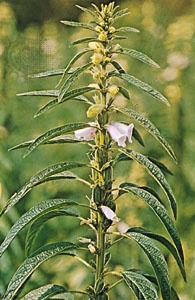 Pedaliaceae, or the sesame family, is a small family of 13 genera and 70 species. Its native distribution is exclusively Old World, in tropical and dry habitats, and its best-known member is Sesamum indicum (sesame). These are herbs or shrubs with spurred flowers and ovaries with axile placentation that often develop hooks or prickles as the fruit wall begins to decompose. Sometimes included in Pedaliaceae, but now recognized as separate, is Martyniaceae, with 5 genera and 16 species of sticky, hairy herbs native to the New World. These have parietal placentation and fruits that can be spectacularly hooked or spurred; for example, Proboscoidea has fruits that can interfere with the shearing of sheep or even get in their eyes or clamp their mouths.
Pedaliaceae, or the sesame family, is a small family of 13 genera and 70 species. Its native distribution is exclusively Old World, in tropical and dry habitats, and its best-known member is Sesamum indicum (sesame). These are herbs or shrubs with spurred flowers and ovaries with axile placentation that often develop hooks or prickles as the fruit wall begins to decompose. Sometimes included in Pedaliaceae, but now recognized as separate, is Martyniaceae, with 5 genera and 16 species of sticky, hairy herbs native to the New World. These have parietal placentation and fruits that can be spectacularly hooked or spurred; for example, Proboscoidea has fruits that can interfere with the shearing of sheep or even get in their eyes or clamp their mouths.Carnivorous (carnivorous plant) families
 There are two families in Lamiales that are carnivorous. The first is Lentibulariaceae, or the bladderwort family, with 3 genera and about 320 species. These are herbs of wet habitats, sometimes even floating aquatics, and they have small to quite large strongly zygomorphic (spurred) flowers with only two anthers. Pinguicula (butterwort) has flat leaves that are sticky on the adaxial surface, and Genlisea (corkscrew plant) has tubular leaves and forked subsurface traps with the opening spiraling along the branches of the fork, while species of Utricularia ( bladderwort) may sometimes actually lack leaves, with the rest of the plant body forming branched systems of tiny insect-collecting bladders with trapdoor entrances. Their typical prey includes protozoans, crustaceans, worms, and newly hatched fish.
There are two families in Lamiales that are carnivorous. The first is Lentibulariaceae, or the bladderwort family, with 3 genera and about 320 species. These are herbs of wet habitats, sometimes even floating aquatics, and they have small to quite large strongly zygomorphic (spurred) flowers with only two anthers. Pinguicula (butterwort) has flat leaves that are sticky on the adaxial surface, and Genlisea (corkscrew plant) has tubular leaves and forked subsurface traps with the opening spiraling along the branches of the fork, while species of Utricularia ( bladderwort) may sometimes actually lack leaves, with the rest of the plant body forming branched systems of tiny insect-collecting bladders with trapdoor entrances. Their typical prey includes protozoans, crustaceans, worms, and newly hatched fish.The second family is Byblidaceae, with a single genus (Byblis) and six species native to Australia and New Guinea. These are herbs with narrowly linear leaves densely covered by glandular hairs that trap and absorb nutrients from insects.
- mackerel
- mackerel shark
- Mackinac Bridge
- Mackinac Island
- Mackinac, Straits of
- Mackinaw City
- Mackinder, Sir Halford John
- MacKinlay Kantor
- MacKinnon, Catharine A.
- MacKinnon, Roderick
- mackintosh
- Mackintosh, Charles Rennie
- Macklin, Charles
- Mackmurdo, Arthur Heygate
- Mack Sennett
- Mack von Leiberich, Karl, Freiherr
- MacLaine, Shirley
- Mac Lane, Saunders
- Maclaren, Charles
- Maclaurin, Colin
- Maclean, Donald
- Maclean, George
- Maclean's
- MacLeary, Donald
- MacLeish, Archibald